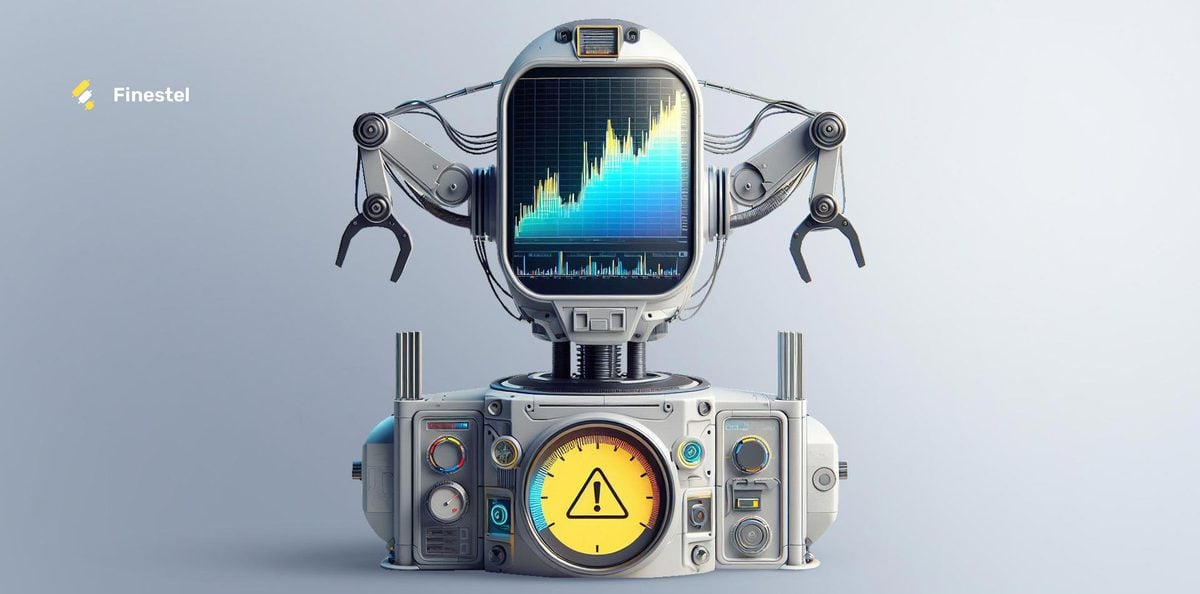In the electrifying realm of financial markets where microseconds can dictate success and fortunes are won or lost in the blink of an eye, high-frequency trading, or HFT, has emerged as the heartbeat of the markets. Algorithms and robots are the new maestros of the markets, executing trades at lightning speed. With the constant development of cutting-edge technology, high-frequency trading is becoming even more accessible to almost all market participants. Therefore, it would be beneficial and arguably, necessary to understand what HFT is.
In this article by Finestel, we focus on what HFT is and how it works. We begin by defining high-frequency trading and move on to present its benefits and drawbacks and introduce a few common strategies for HFT. Moreover, we put considerable emphasis on the risks and limitations of high-frequency trading. Finally, we suggest a few workarounds and solutions to move beyond these limitations and mitigate the potential risks mentioned earlier.
What is High-Frequency Trading?
High-frequency trading (HFT) is a sophisticated and lightning-fast strategy employed in the financial markets. It involves the execution of a large number of trades within incredibly short timeframes. To illustrate what we mean by “incredibly short”, entries and exits can be in seconds or even shorter periods.

At its core, high-frequency trading utilizes complex algorithms and robots to analyze market data and execute potential trade signals. These bots and algorithms surpass human speed capabilities and are able to capitalize on opportunities that become available in a short time period. This high-speed approach is possible thanks to the advent of computer technology and of course, convenient market access from all around the globe using the internet.
High-frequency trading represents a paradigm shift in the world of finance and trading. The traditional image of traders gathering on the trading floors and shouting their orders at market open is fading away and a digitized world of robots and artificial intelligence is taking its place. However, while many market participants believe that algorithms and HFT have brought efficiency and accuracy to trading, debates have also arisen regarding their potential risks and limitations.
How High-Frequency Trading Works
HFT is the result of advanced technology and lightning-fast decision-making processes. The process begins with the development of sophisticated algorithms that are crafted to analyze vast amounts of market data in real time. These algorithms are typically coded in programming languages like high-frequency trading Python bots. They can be designed to identify patterns, trends, and inefficiencies in price delivery and other defining factors like volume. Therefore, HFT algorithms are constantly looking for opportunities to exploit for quick, consistent profits.

While even retail traders have access to HFT tools and software nowadays, most advanced high-frequency trading systems are usually located in close proximity to financial exchanges to minimize latency and its potentially damaging effects on the system’s profitability.
Once algorithms identify a favorable trade signal, the system swiftly generates and executes orders, often in a matter of microseconds. These orders can involve buying or selling different financial instruments such as stocks, crypto, and even derivatives like options and futures. Therefore, HFT is quickly becoming a mainstream method to trade any financial market, from anywhere around the world.
The Role of Automation in HFT
Automation plays a pivotal role in high-frequency trading. It serves as the backbone that enables the high-speed, efficient execution of trades. At the heart of HFT, sophisticated algorithms automate the decision-making process by analyzing a huge volume of datasets. They also take care of the executions, ensuring maximum accuracy in the absence of human errors.

The use of algorithms and automation enables the execution of a large number of trades within milliseconds, something no human is naturally capable of doing. High-frequency trading systems are designed to automatically respond and adapt to the constantly changing market environment. The most advanced algorithms that utilize artificial intelligence are able to optimize their performance in various market conditions. Therefore, while many might assume the other way, the role of automation is beyond just speed in high-frequency trading.
Quantitative vs High-Frequency Trading; Are they Different?
Quantitative trading and high-frequency trading are from a distinct but interconnected realm within the world of algorithmic trading. Both involve using advanced mathematical models and automated trading strategies. However, they are different in their primary focus and time horizons.
Quantitative trading strategies rely on quantitative analysis to make informed decisions based on data. These trades can be done on various timeframes, ranging from minutes to days. Yet, HFT is a subset of quantitative trading that focuses on executing a large number of orders in extremely short timeframes. While both use data-driven decision-making, HFT strategies focus on speed as their advantage and aim to exploit micro-level market inefficiencies for profit.
How Does Cryptocurrency High-Frequency Trading Work?
High-frequency trading has found a rapidly evolving playground in the cryptocurrency space. The decentralized, 24/7 nature of the crypto market matches that of HFT algorithms quite well. High-frequency trading crypto bots are constantly monitoring the market and executing trades on assets like Bitcoin and Ethereum, as they are cryptos with the highest trading volume and deepest orderbook.
HFT crypto bots can be designed by a list of high-frequency prop trading firms or even individual traders and developers. You can also utilize these bots on high-frequency crypto trading platforms. These algorithms are typically connected to exchanges with the largest volume and lowest latency in order executions and aim to profit from the significant volatility of the crypto asset class.
Common High-Frequency Trading Strategies
Similar to any other form of trading, HFT can be done through a plethora of different strategies. These strategies are all used for different purposes and concepts to generate profits. Some of the most common of these strategies are listed below.
Market-Making
Some HFT firms and teams that possess considerable capital choose to engage in market-making. They act as liquidity providers in the market by constantly buying and selling the financial instrument. The main target for market makers is to profit from the bid-ask spread, while they also contribute to reducing the spread with their activities.
Market-making strategies are relatively low-risk methods to generate consistent but small profits from the market. However, they require significant amounts of capital and also, suitable software to implement high-frequency trading.
Statistical Arbitrage
Statistical arbitrage is mainly considered a quantitative trading strategy. Conducting statistical arbitrage strategies involves identifying and exploiting deviations from expected correlations between various financial assets. These correlations are themselves derived from statistical models, hence the name, statistical arbitrage.
These strategies mostly rely on principles of mean reversion, an asset price’s tendency to return to its historical average over time. Therefore, when deviations occur, traders execute positions to profit from the potential reversion. To succeed in implementing this strategy, high-frequency traders must ensure that their underlying statistical models are accurate and their HFT software is capable of executing at high speed. Compared to the market-making strategy, statistical arbitrage involves more risk and typically, more reward.
Cross-Exchange Arbitrage
Cross-exchange arbitrage is another common type of high-frequency trading strategy, especially in the crypto market. It involves exploiting price differentials between the same asset on different exchanges. For executing cross-exchange arbitrage strategies, it is necessary to utilize advanced algorithmic systems with high-speed executions and connectivity to the exchanges.
HFT firms and teams who implement this strategy regularly monitor the order books and prices on various exchanges to identify price differentials. After the identification step, executing the trade opportunity is next. The HFT algorithm quickly executes buy or sell orders to generate profits. Interestingly, the presence of arbitragers makes these price differentials diminish. Cross-exchange arbitrage strategies, if implemented correctly, can provide consistent, small profits with low risk.
Trend Following
Trend-following strategies are another type of prominent high-frequency trading strategy. Unlike traditional trend-following strategies that may span days or weeks, HFT trend strategies operate rapidly and in very short timeframes. These strategies rely on riding the market momentum in real time and profiting from the trend.
HFT algorithms for trend following utilize various technical indicators and price patterns. They continuously monitor market data and analyze price movements to identify potential setups. Trend-following strategies involve more risk than other strategies discussed, and subsequently, more reward.
News-Based Trading
Some advanced HFT algorithms are capable of quickly analyzing news feeds and economic data releases to determine market sentiment. Then, they can use this information to their advantage by executing trades at lightning speed.
However, inaccuracy in analyzing the news and economic metrics and consequently, anticipating a wrong direction could result in a huge loss. Therefore, without lightning-fast HFT software, these strategies are doomed. Needless to say, news trading is a high-risk strategy but can also yield high gains.
HFT in a Limit Order Book
High-frequency trading in a limit orderbook (LOB) refers to the use of advanced algorithms and rapid executions within the context of an order book. Order books are continuously updated in real-time and to trade based on them, HFT traders or teams require a sophisticated, high-speed algorithm to keep up with the market.
These strategies focus on profiting from micro-level market inefficiencies and liquidity imbalances. These inefficiencies often exist for very short durations. Therefore, they need to study the order book for patterns and trends and execute in milliseconds in order to be profitable. This strategy can also be a high-risk one, as it involves pattern identification and anticipation of price movements.
The Benefits and Drawback of High-Frequency Trading
High-frequency trading is undoubtedly a magnificent tool to take trading to the next level as it offers numerous advantages to traders. However, it is also associated with a few drawbacks that could act as hindrances to your trading career, if not handled with extra care.

How Do HFT Systems Facilitate Trading?
As already pointed out in the article, there are several significant advantages to utilizing high-frequency trading strategies. Here are some of the primary benefits of HFT:
- Increase Speed: The primary benefit that using HFT provides is the ability to execute trades at lightning speed. It allows traders to capitalize on various market opportunities in fractions of seconds, as it quickly reacts and adapts to price changes.
- Improve Accuracy: High-frequency trading involves using robots and automated algorithms. Therefore, there is no human error involved in the process. This elevates the level of precision in executing trading strategies, taking traders a step closer to profitability.
- Liquidity Provision: High-frequency traders are not the only group of market participants who benefit from HFT. This system contributes to market liquidity as it constantly engages in buying and selling. Therefore, it can lead to tighter bid-ask spreads and easier executions for other traders.
- Price Discovery: The rapid execution of trades by huge firms that trade HFT systems with high volume causes more efficient price discovery. These algorithms and robots quickly incorporate new information into asset prices and consequently improve market efficiency.
- Reduced Trading Costs: Automation of trading processes can significantly reduce transaction costs. The efficiency of electronic trading platforms paired with the elimination of human intermediaries can result in lower trading fees.
- Exploiting Arbitrage Opportunities: High-frequency trading systems excel at identifying and capitalizing on small price discrepancies across different markets or exchanges. This form of arbitrage, while producing profits for traders, also increases market efficiency by quickly re-aligning prices among different markets.
What Are the Drawbacks of High-Frequency Trading?
High-frequency trading (HFT) is not without its drawbacks. Many stakeholders have voiced their concerns regarding this takeover of the markets by robots over the recent years. Some of the prominent disadvantages of HFT are listed below:
- Market Instability: Some critics argue that HFT can contribute to market instability, especially during times of extreme volatility. Rapid and large-scale executions can aggravate market swings and pose significant risks to all investors and financial institutions.
- Unequal Access: High-frequency trading firms often invest heavily in technology and infrastructure to gain a speed advantage. However, you cannot find their codes and algorithms easily by just searching for them on high-frequency trading GitHub topics. This behavior creates a potential imbalance in market access.
- Lack of Transparency: Most advanced HFT algorithms are kept secret. This results in a lack of transparency in the market. Therefore, it would make high-frequency trading regulation much more difficult.
- Job Displacement: The automation inherent in HFT can result in job displacement as robots are taking the places of traditional traders and market makers. Therefore, the takeover of algorithms will result in job losses and affect the employment landscape of the financial industry.
- Significant Operational Costs: Building and maintaining high-frequency trading software and hardware involve substantial costs. These include the need for hardware upgrades and advanced software development, as well as constant repairs and debugs.
- High Trading Fees: While we previously mentioned that utilizing HFT can reduce transaction fees, it is a two-edged sword. In case of mishandling, it can incur huge costs in the shape of trading fees as a result of numerous executions.
The Risks and Limitations of High-Frequency Trading
- Liquidity Evaporation: While HFT can contribute to overall market liquidity, it can also cause liquidity evaporation during times of stress. HFT algorithms may quickly withdraw from the market which could cause massive liquidity crises.
- Risk of Manipulation: HFT has the potential to be utilized for market manipulation by the whales, as they can create artificial supply or demand to affect prices. This raises concerns about the integrity of market pricing.
- Flash Crashes: The speed that HFT operates with can be directly linked with flash crashes, which are sudden downward price movements in short periods. Algorithmic glitches are usually one of the main culprits for such events that inflict heavy losses on investors and the economy as a whole.
- Data Security: HFT systems process vast amounts of data. Therefore, they are susceptible to cybersecurity threats. Breaches or attacks on HFT infrastructure can pose significant risks to investors and the financial sector.
- Technological Dependency: The success of algorithmic and high-frequency trading heavily relies on advanced technological infrastructure. Therefore, malfunctions and technical issues can lead to significant financial losses.
- Risk of Over-Optimization: HFT algorithms are often tuned to perform well in the past and this creates the risk of over-optimization. Algorithms that work exceptionally well on historical data might not adapt effectively to real-time market conditions.
- Limited Predictive Power: High-frequency trading strategies are generally focused on exploiting short-term market inefficiencies rather than predicting longer-term market moves. This limitation can be challenging to many investors.
- Connectivity and Response Time Issues: In the realm of High-Frequency Trading (HFT), the effectiveness of strategies depends heavily on the speed at which traders can connect to exchanges and execute trades. Two critical factors influencing this connectivity are the exchanges’ ping time and response time.
Innovative High-Frequency Trading Workarounds
To address the limitations and risks of using high-frequency trading strategies involves implementing workarounds and alternative strategies. Some of these solutions are listed in the following sections.
Algorithmic Innovation and Technology Upgrades
In order to stay competitive in the high-frequency trading space, consistent innovation is essential. Therefore, HFT companies invest heavily in research and development to take their algorithms to the next level.
Regular technological upgrades to hardware and software infrastructure are also necessary. To gain a competitive edge, HFT firms focus on developing cutting-edge technology and infrastructure to improve both ping time and response time and minimize latency.
Diversification and Other Risk Management Protocols
When it comes to numerous, fast executions, robust risk management protocols are crucial. These protocols would help stop losing streaks caused by bugs or glitches. Consequently, a well-designed risk management plan would limit potential losses and prevent disastrous events that lead to significant drawdowns.
Moreover, HFT firms and traders often diversify their strategies. They do so to reduce their exposure on each approach. Diversification is one of the most simple, yet effective risk management strategies. Therefore, high-frequency traders use different types of algorithms simultaneously and avoid over-allocating to a single one.
Transparency Initiatives
As previously mentioned, regulation is one of the primary challenges when it comes to the HFT space. Sophisticated software and confidentiality of the strategies makes regulators’ life very difficult.
As a result, firms practice demonstrating transparency and disclosing useful information about trading activities. These efforts can help reduce the concerns related to market fairness and regulatory issues.
Increasing Order Rate and IP Rate Limits
Another workaround that HFT teams and firms employ is negotiating with exchanges to increase the rate limits. Order rate limits and IP rate limits determine the frequency at which you can execute trades and are one of the key factors when it comes to high-frequency trading.
Education and Training
In a space where firms and companies invest millions of dollars to develop advanced high-frequency trading software, there is no doubt that sole traders and small trading teams will have a hard time. Therefore, like any other practice, especially in the financial markets, traders should always focus on educating themselves and continuously train and optimize their strategies. This way, they will be able to limit their potential drawdown and prevent catastrophic events that would inflict considerable financial damage on them.
Discover the top-rated crypto trading courses.
Can HFT Traders Utilize Finestel’s Innovative Solutions?
Finestel caters to a wide range of traders and asset managers. As a trading technology solution provider, we offer services like a cutting-edge crypto copy trading platform and white-label asset management software that is fully customizable and tailored to your business requirements.
As a professional HFT trader, you can connect your high-frequency trading crypto bot to Finestel’s services and use our copy trading platform or our white-label software to manage investor capital. Finestel supports the top cryptocurrency exchanges and you can engage in HFT crypto trading on Binance as well as implementing HFT on Bybit/OKX/Kucoin. With the extremely low latency that Finestel’s copy trading bot offers, you will never need to worry about late executions and subsequent losses.
Learn expert strategies to appeal to high net worth investors.
Conclusion
In this article, we thoroughly explained what high-frequency trading, or HFT is and how it works. We introduced a number of different strategies that most HFT traders and firms utilize and listed the pros and cons of engaging in high-frequency trading. It became evident that while HFT can be highly beneficial, it also involves several drawbacks and risks.
To address those limitations, we briefly presented some workarounds to tackle the potential issues that arise from high-frequency trading. HFT is very similar to other forms of trading and requires a strict algorithmic trading risk management plan. Moreover, you should constantly educate yourself on the concepts related to algorithms, bots, and trading in general, to be able to efficiently operate a high-frequency trading system.





Leave a Reply